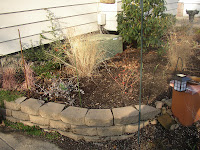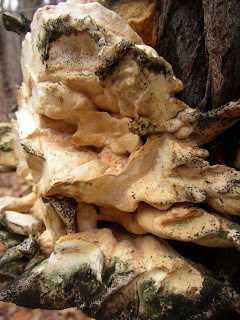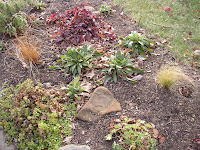Everyone wishes that they did things a little differently, in one area of life or another. I am as well aware of my shortcomings as the next girl, but that doesn't mean that I feverishly scan the self-help aisle of my local bookstore on a daily basis. Instead of agonizing over them, I tend to embrace my faults as mere... idiosyncrasies.
Although I very rarely actually keep them, I feel obligated to list resolutions every new year anyway. Maybe I do it to keep myself humble, maybe there's some small part of me that actually holds out hope that I might work on them, who knows. But here are the resolutions that pertain to my garden, in no particular order:
In 2007, I resolve to allow plants to actually grow in the spots where they are planted.
 This seems like a no brainer, doesn't it? Isn't the idea to plant things, give them time to grow, and enjoy the beauty as they mature? Somehow, I find it darn near impossible to do, as these pictures show. The first picture is from the fall of 2005, just after I planted and mulched the orange-berried pyracantha.The second picture is from late summer 2006.
This seems like a no brainer, doesn't it? Isn't the idea to plant things, give them time to grow, and enjoy the beauty as they mature? Somehow, I find it darn near impossible to do, as these pictures show. The first picture is from the fall of 2005, just after I planted and mulched the orange-berried pyracantha.The second picture is from late summer 2006. At first glance, I'm not doing too badly--the pyracantha and the iris are still there, right? The 'Chocolate Chip' ajuga, variegated hosta and zebra grass moved to new homes. 'Hopi Red Dye' amaranth, 'Mainacht' salvia, peppermint, Japanese bloodgrass and a few types of sweet potato vines entered the picture. (I should confess that the SPVs took the place of some cerinthe and 'Detroit Dark Red' beets that had departed of their own accord by August.)
At first glance, I'm not doing too badly--the pyracantha and the iris are still there, right? The 'Chocolate Chip' ajuga, variegated hosta and zebra grass moved to new homes. 'Hopi Red Dye' amaranth, 'Mainacht' salvia, peppermint, Japanese bloodgrass and a few types of sweet potato vines entered the picture. (I should confess that the SPVs took the place of some cerinthe and 'Detroit Dark Red' beets that had departed of their own accord by August.) Now check out this picture of the same spot, taken this week. Only the pyracantha--which is being trained against the wall--and the rhododendron are still in the same places right now. Various other types of ornamental grasses, some groundcover sedums that I would like to see cover the wall, a blueberry, garlic, goatsbeard, and several other plants have joined them.
Now check out this picture of the same spot, taken this week. Only the pyracantha--which is being trained against the wall--and the rhododendron are still in the same places right now. Various other types of ornamental grasses, some groundcover sedums that I would like to see cover the wall, a blueberry, garlic, goatsbeard, and several other plants have joined them.Oh, and remember that variegated hosta in the first picture? It was split into 3 plants earlier this summer, with each of those 3 plants being moved individually several times as well. Two of them are no longer residents of my garden at all. Shameful.
In 2007, I resolve to finish one project before I allow myself to begin another.
Ah, who am I trying to kid. Scroll down to my Gallery of Shame post from June 13th and look at those unfinished projects. Of the ones listed, I have only completed #4--and I added a few more unfinished garden projects later in the year as well. This is one resolution that is never going to come to fruition... but a girl can dream, right?
In 2007, I resolve to preserve more of my garden's bounty.
 This one actually has a chance of happening. I ate all of the peppers I grew last year, but there were not nearly so many in 2006 as you see here in a picture from 2005. I failed to harvest even half of the cherry tomatoes this year, the dog ate more beans out of the garden than I did, and not enough of my zucchini was transformed into bread before it went bad.
This one actually has a chance of happening. I ate all of the peppers I grew last year, but there were not nearly so many in 2006 as you see here in a picture from 2005. I failed to harvest even half of the cherry tomatoes this year, the dog ate more beans out of the garden than I did, and not enough of my zucchini was transformed into bread before it went bad.This year, I am planning better. Less green beans, more peas and yellow squash so I have more variety. More plum tomatoes so I am more inclined to put them up as sauce or salsa--and basil, for the same reason.
You know, now that I have a blog I just may be more accountable about things like New Year's Resolutions. After all, when I sit down to write my resolutions for 2008 I will probably revisit this post to see how far I've come. Maybe I'll even have finished the projects in my Gallery of Shame!






























